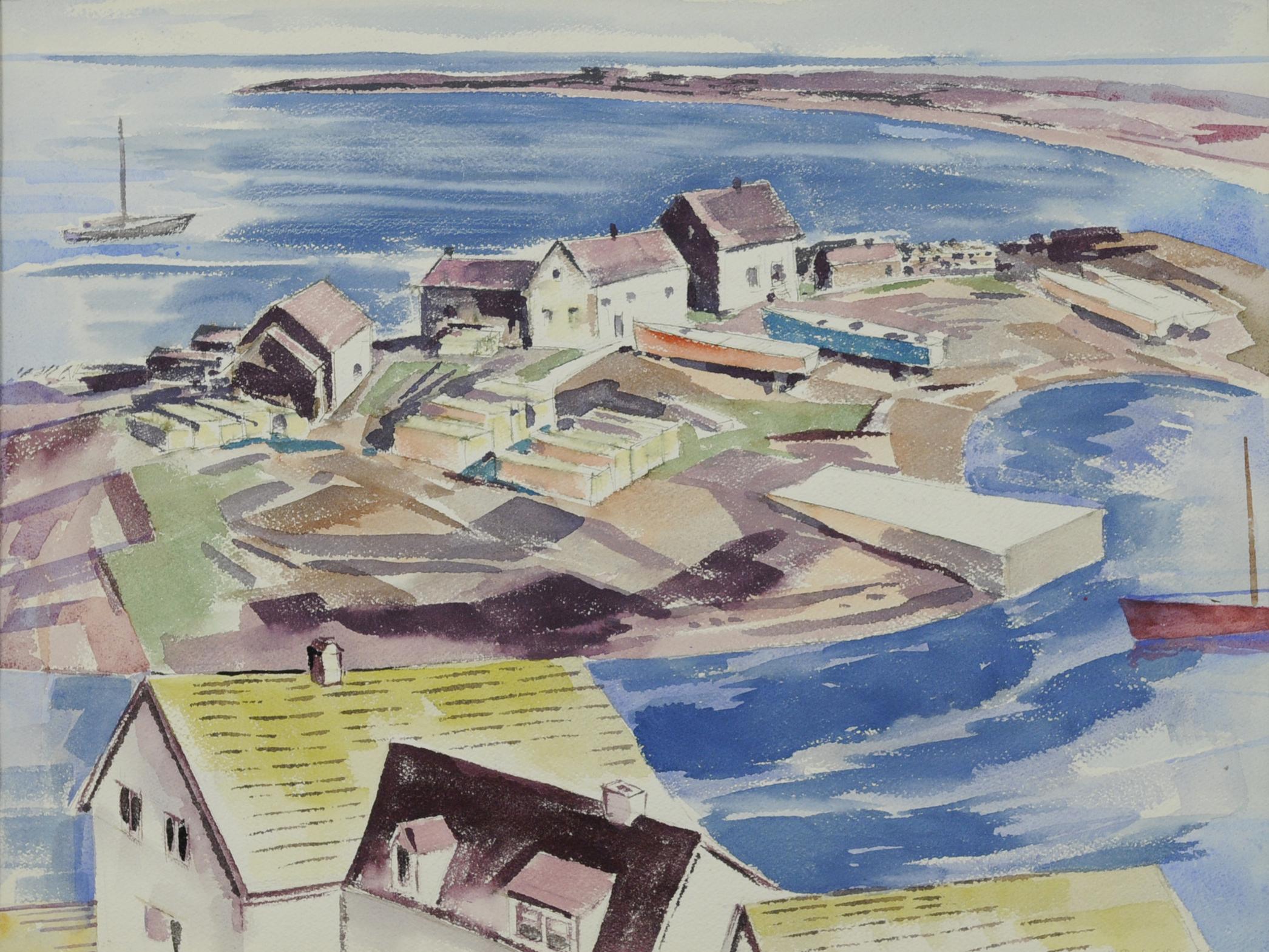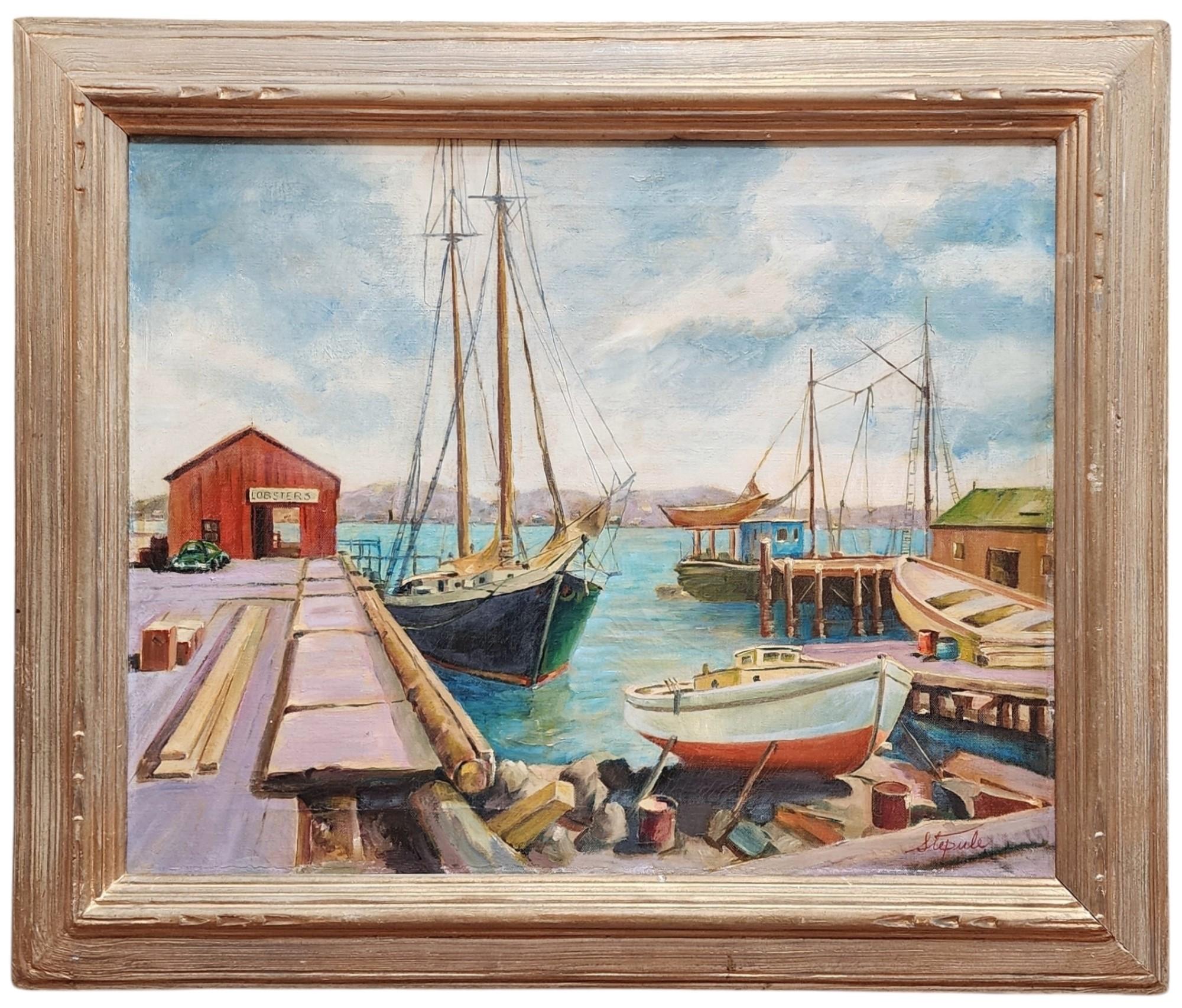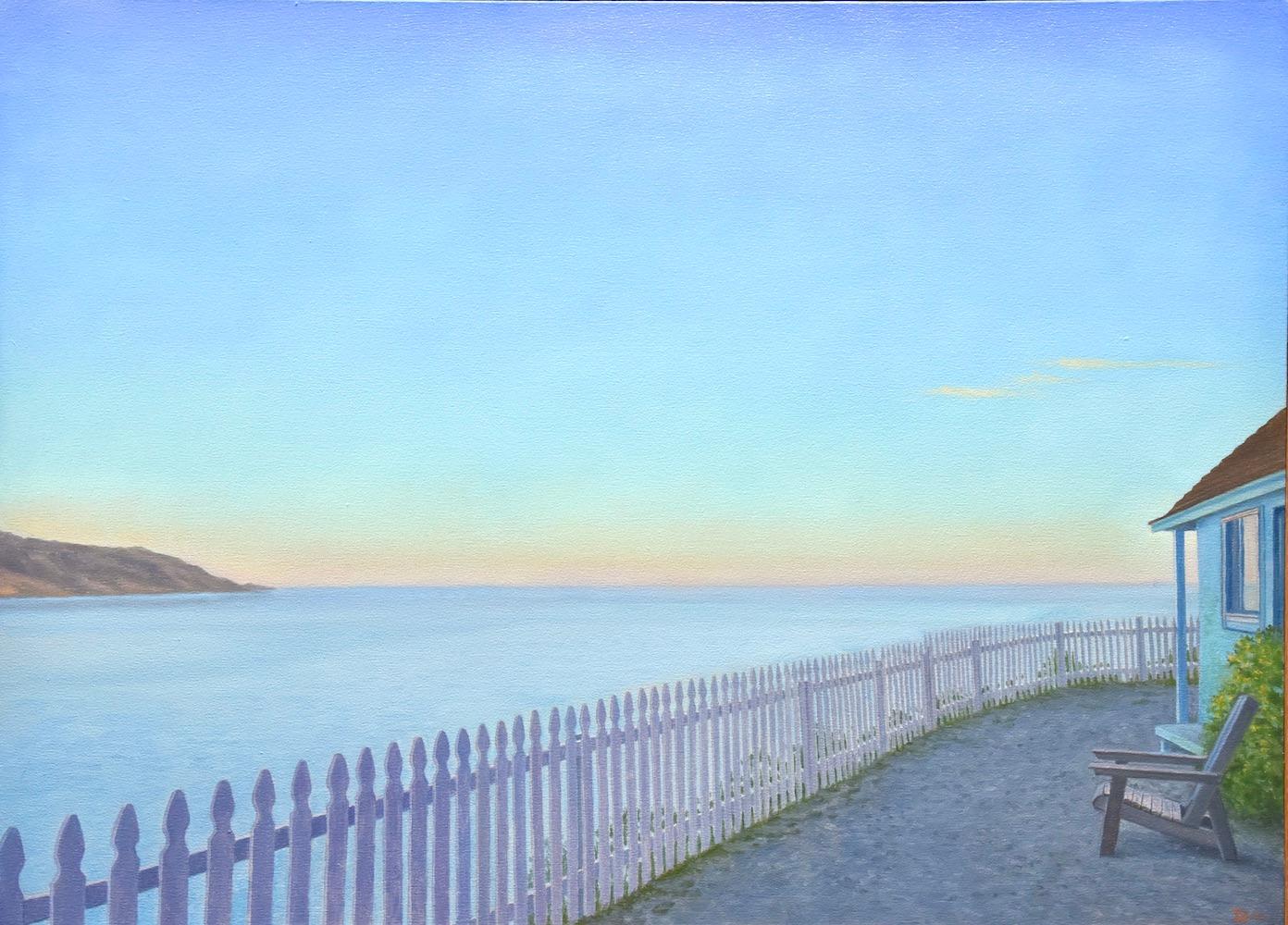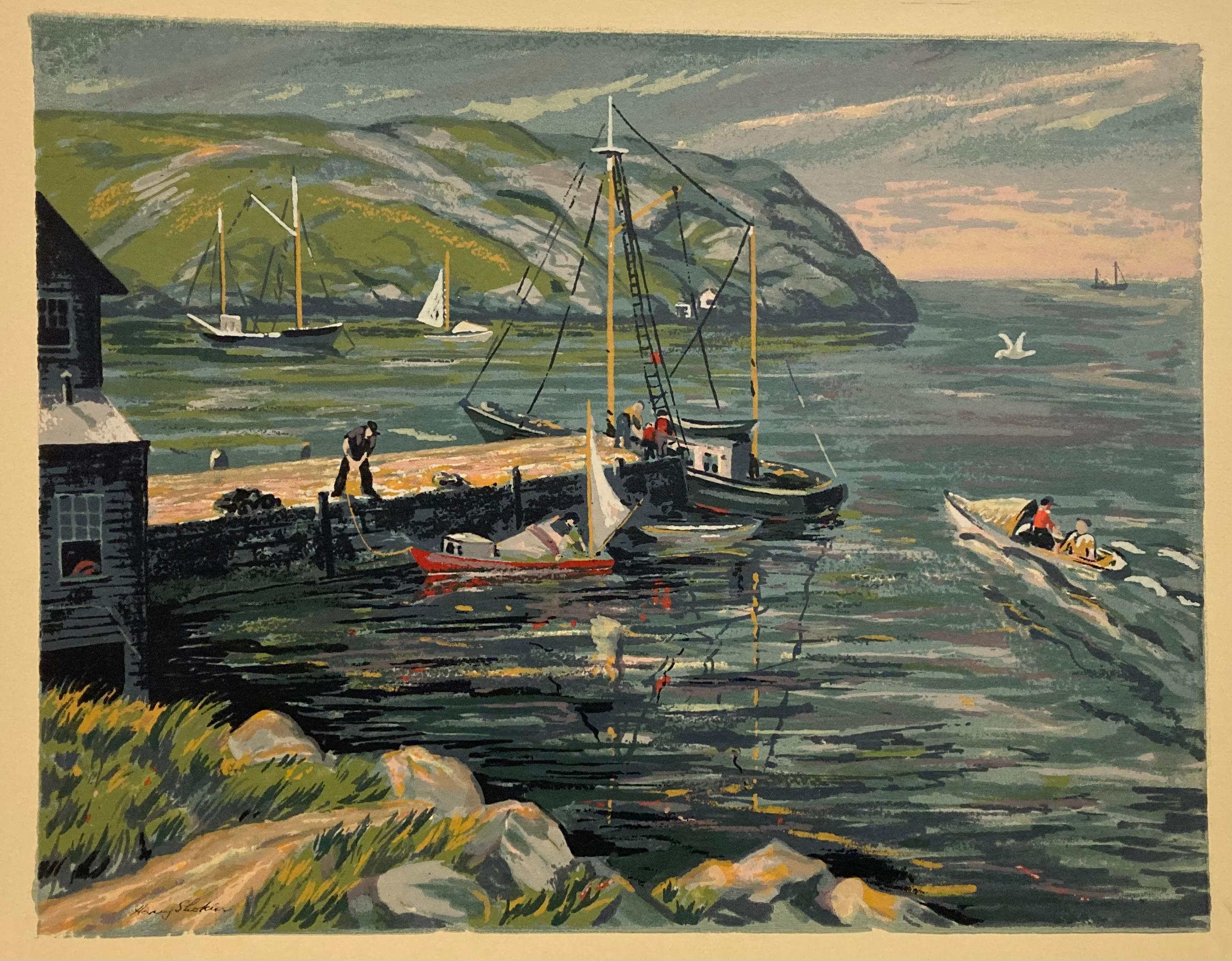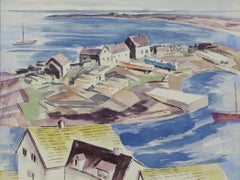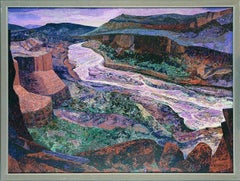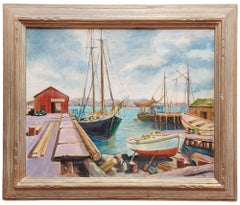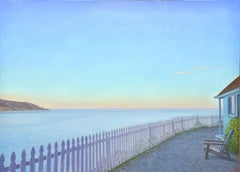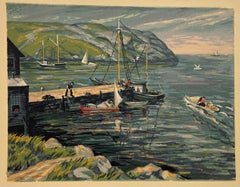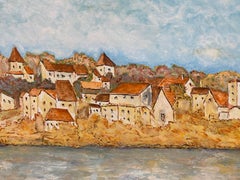Want more images or videos?
Request additional images or videos from the seller
1 of 8
William C. GrauerGaspe Homesc. 1970
c. 1970
$6,000
£4,580.16
€5,265.20
CA$8,443.07
A$9,389.05
CHF 4,931.33
MX$114,790.52
NOK 61,449.11
SEK 57,929.91
DKK 39,295.42
About the Item
Title Unknown (Gaspe Bay Houses)
Acrylic on board, 46 1/4 x 34 inches
Signed lower right
Condition: Good
Minor surface wear to the frame
Provenance: Estate of the artist
by decent to his daughter Gretchen
William C. Grauer (1895-1985)
William C. Grauer (1895-1985) was born in Philadelphia to German immigrant parents. After attending the Philadelphia Museum School of Industrial Art, Grauer received a four year scholarship from the City of Philadelphia to pursue post graduate work. It was during this time that Grauer began working as a designer at the Decorative Stained Glass Co. in Philadelphia.
Following his World War I service in France, Grauer moved to Akron, Ohio where he opened a studio in 1919 with his future brother-in-law, the architect George Evans Mitchell. Soon, the Rorimer-Brooks design company, the developer Van Swerngen brothers, as well as the Sterling Welch and Halle Bros. department stores realized the extent of Grauer's talent and eagerly employed him. Grauer’s work during this time included architectural renderings for Shaker Square, Moreland Courts, and other many other projects commissioned by Cleveland architects. Grauer also remained true to his roots as a master designer of stained glass windows. With his work in such high demand, Grauer received a commission in 1921 to paint murals for the French Grill Room of the Kansas City Club. Later, he also worked for the Cleveland Builders Exchange in 1928.
In the 1920s, Grauer had a studio in the Old Fine Arts Building in Cleveland, where he met his future wife and fellow Philadelphian, Natalie Eynon Grauer, whom he married in 1924. After creating murals for the Greenbrier Hotel in White Sulfur Springs, West Virginia in 1932, together Grauer and his wife founded and co-directed the successful Old White Art Colony, School and Gallery, which they continued to frequent during the summer months in the 1930s and 1940s. Grauer’s involvement in West Virginia also included his West Virginia murals for the West Virginia exhibitions at the 1933 Century of Progress Exhibition in Chicago and the 1939 World’s Fair in New York City.
Back in Ohio, Grauer became affiliated with Cleveland College, one of the component colleges of Western Reserve University, which later became Case Western Reserve University. According to Jill Tatem, assistant university archivist with Case Western Reserve University, Grauer was a lecturer in art at Cleveland College from 1934 to 1948, associate professor of art from 1948 to 1966, and then an associate professor emeritus. Following the death of his wife in 1955, he married another Cleveland College art instructor, Dorothy Turobinski, in 1964. After Grauer retired from Western Reserve University in 1966, he continued to paint and teach privately until his death in 1985 at age 89.
Grauer's work is in the collections of numerous Museums including The Cleveland Museum of Art, the Whitney Museum of American Art in New York, and the Smithsonian Institution in Washington D.C.
- Creator:William C. Grauer (1896, American)
- Creation Year:c. 1970
- Dimensions:Height: 46.25 in (117.48 cm)Width: 34 in (86.36 cm)
- Medium:
- Movement & Style:
- Period:
- Condition:Note: Surface wear to the original hand painted by with colors chosen by the artist.
- Gallery Location:Fairlawn, OH
- Reference Number:Seller: FA115751stDibs: LU1406281172
About the Seller
5.0
Recognized Seller
These prestigious sellers are industry leaders and represent the highest echelon for item quality and design.
Platinum Seller
Premium sellers with a 4.7+ rating and 24-hour response times
Established in 1978
1stDibs seller since 2013
809 sales on 1stDibs
Typical response time: <1 hour
Associations
International Fine Print Dealers Association
- ShippingRetrieving quote...Shipping from: Fairlawn, OH
- Return Policy
Authenticity Guarantee
In the unlikely event there’s an issue with an item’s authenticity, contact us within 1 year for a full refund. DetailsMoney-Back Guarantee
If your item is not as described, is damaged in transit, or does not arrive, contact us within 7 days for a full refund. Details24-Hour Cancellation
You have a 24-hour grace period in which to reconsider your purchase, with no questions asked.Vetted Professional Sellers
Our world-class sellers must adhere to strict standards for service and quality, maintaining the integrity of our listings.Price-Match Guarantee
If you find that a seller listed the same item for a lower price elsewhere, we’ll match it.Trusted Global Delivery
Our best-in-class carrier network provides specialized shipping options worldwide, including custom delivery.More From This Seller
View AllGaspe: St. Lawrence Village
By William Grauer
Located in Fairlawn, OH
Signed by the artist in pencil, lower right
Provenance:
Estate of the Artist
With the artist's original presentation (Frame and matting)
Two similar titles were exhibited in The ...
Category
1950s American Modern Landscape Drawings and Watercolors
Materials
Watercolor
Gaspe: St. Lawrence Village
By William Grauer
Located in Fairlawn, OH
Signed by the artist in pencil, lower right
Provenance:
Estate of the Artist
With the artist's original presentation (Frame and matting)
Two similar titles were exhibited in The ...
Category
1950s American Modern Landscape Drawings and Watercolors
Materials
Watercolor
Gaspe: St. Lawrence Village
By William Grauer
Located in Fairlawn, OH
Signed by the artist in pencil lower right
Provenance:
Estate of the Artist
References And Exhibitions:
With the artist's own original presentation (frame and matting)
Two simil...
Category
1950s Landscape Drawings and Watercolors
Materials
Watercolor
Canyon Country
By William C. Grauer
Located in Fairlawn, OH
Acrylic on board
Signed lower right corner
Condition: Painting is excellent
Frame has surface wear
Provenance: Estate of the artist
William C. Grauer (1895-1985)
William C. Grauer (1895-1985) was born in Philadelphia to German immigrant parents. After attending the Philadelphia Museum School of Industrial Art, Grauer received a four year scholarship from the City of Philadelphia to pursue post graduate work. It was during this time that Grauer began working as a designer at the Decorative Stained Glass Co. in Philadelphia.
Following his World War I service in France, Grauer moved to Akron, Ohio where he opened a studio in 1919 with his future brother-in-law, the architect George Evans...
Category
1970s American Modern Landscape Paintings
Materials
Acrylic, ABS
Seascape
By George Adomeit
Located in Fairlawn, OH
Seascape (Off Monhegan, Maine)
Oil on canvas, mounted to board by the artist, c. 1940
Signed: George G. Adomeit lower right
A view of the Maine coas...
Category
20th Century American Impressionist Landscape Paintings
Materials
Oil
$7,500
Irish Sea
By Edward Dobrotka
Located in Fairlawn, OH
Irish Sea
Watercolor, 1947
Signed and dated by the artist lower right
Condition: Excellent
Image/Sheet size: 12 x 18 inches
Provenance: Estate of the Artist
...
Category
1940s American Realist Landscape Drawings and Watercolors
Materials
Watercolor
You May Also Like
Rockport Harbor
By Charles Stepule
Located in Grand Rapids, MI
Charles Stepule (American, 1911 - 2006)
Signed: Stepule (Lower, Right)
" Rockport Habor ", circa 1970s
Oil on Canvas
16" x 20"
Housed in a 2 1/2 Carved Frame
Overall Size: 21 ...
Category
Mid-20th Century Post-War Landscape Paintings
Materials
Canvas, Oil
Motel by the Sea
By Willard Dixon
Located in Burlingame, CA
Inspired by a quiet inn by the sea, in Big Sur, California. Painted in 2022. The Painting is 29" x 40", artist framed and ready to hang and enjoy.
One of our finest American contemp...
Category
21st Century and Contemporary Contemporary Landscape Paintings
Materials
Canvas, Oil
Harry Shokler, Island Harbor
By Harry Shokler
Located in New York, NY
Harry Shokler used serigraphy to great advantage in this landscape. It's colorful and detailed.
It is signed in the image at the lower left. When printmakers began making serigraphs...
Category
1940s American Modern Figurative Prints
Materials
Screen
1950's French Modernist/ Cubist Painting - French Houses On Hill
By Bernard Labbe
Located in Cirencester, Gloucestershire
French Landscape
by Bernard Labbe (French mid 20th century)
original watercolour/ gouache on artist paper, unframed
size: 13.75 x 19 inches
condition: very good and ready to be enjoy...
Category
Mid-20th Century Modern Landscape Paintings
Materials
Watercolor, Gouache
New England Coastal Town Landscape w/ Houses, Cleveland School Woman Artist
Located in Beachwood, OH
Kae Dorn Cass (American, 1901-1971)
New England Coastal Town
Watercolor on paper
Signed lower right
9 in. h. x 11.5 in. w.
17 in. h. x 19 in. w., as framed
Kae Dorn Cass was born...
Category
Mid-20th Century Figurative Drawings and Watercolors
Materials
Watercolor
Coastal Scene, 20th Century Seascape, Cleveland School Artist
By George Adomeit
Located in Beachwood, OH
George Gustav Adomeit (American, 1879-1967)
Coastal Scene
Oil on canvas
Signed lower left
19 x 23 inches
21.5 x 25.5 inches, framed
A major painter of American scene subjects, Georg...
Category
20th Century American Modern Figurative Paintings
Materials
Oil
